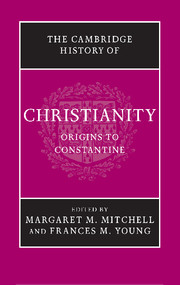Book contents
- Frontmatter
- Prelude: Jesus Christ, foundation of Christianity
- Part I The Political, Social and Religious Setting
- Part II The Jesus Movements
- Part III Community Traditions and Self-Definition
- Part IV Regional Varieties of Christianity in the First Three Centuries
- Part V The Shaping of Christian Theology
- 23 Institutions in the pre-Constantinian ecclēsia
- 24 Monotheism and creation
- 25 Monotheism and Christology
- 26 Ecclesiology forged in the wake of persecution
- 27 Towards a Christian paideia
- Part VI ‘Aliens’ become Citizens: towards Imperial Patronage
- Conclusion: retrospect and prospect
- Bibliographies
- Index
- Map 1. The Roman Empire in the time of Marcus Aurelius
- References
25 - Monotheism and Christology
from Part V - The Shaping of Christian Theology
Published online by Cambridge University Press: 28 March 2008
- Frontmatter
- Prelude: Jesus Christ, foundation of Christianity
- Part I The Political, Social and Religious Setting
- Part II The Jesus Movements
- Part III Community Traditions and Self-Definition
- Part IV Regional Varieties of Christianity in the First Three Centuries
- Part V The Shaping of Christian Theology
- 23 Institutions in the pre-Constantinian ecclēsia
- 24 Monotheism and creation
- 25 Monotheism and Christology
- 26 Ecclesiology forged in the wake of persecution
- 27 Towards a Christian paideia
- Part VI ‘Aliens’ become Citizens: towards Imperial Patronage
- Conclusion: retrospect and prospect
- Bibliographies
- Index
- Map 1. The Roman Empire in the time of Marcus Aurelius
- References
Summary
“If these people worshipped no other god but one, perhaps they would have a valid argument against the others. But in fact they worship to an extravagant degree this man who appeared recently, and yet think it is not inconsistent with monotheism if they also worship his servant.
(Celsus, quoted by Origen)This theological problem lay at the heart of early Christianity, but explicit argument about how to deal with it conceptually is not found until the third century with the ‘monarchian’ controversies. A model of development has usually been used to trace a process whereby Christian doctrine was formulated. Here, however, a more dialectical approach is adopted. Doctrinal discourse was created by argument and counter-argument; conceptual models were produced in the fires of controversy. To put it another way, for orthodoxy to be discovered the counter-proposals of heresy were vital. It is in this sense that the third century is crucial for responding to Celsus’ question. As an outsider, he perhaps perceived earlier and more clearly than believers what the distinctive mark of Christianity was, and how logically absurd it was.
In the writings of the first and second centuries, different portraits and different expectations are associated with Jesus, many exploring the idea that in some sense he is the pre-existent agent of the one true God (famously John 1:1–18; cf. 1 Cor 8:6; Phil 2:5–10). Furthermore, the immediate response to Jesus was one of reverence and awe, and a rhetoric of worship is traceable in hymnody and confession already in the New Testament.
Keywords
- Type
- Chapter
- Information
- The Cambridge History of Christianity , pp. 452 - 469Publisher: Cambridge University PressPrint publication year: 2006

